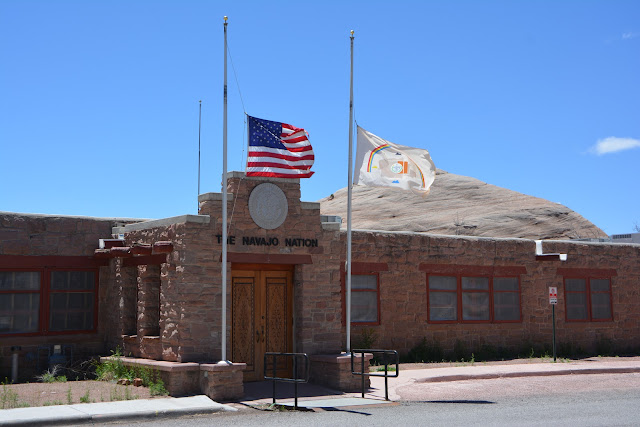After leaving Canyon del Muerto and Canyon de Chelly behind, we drove to Tsaile, with the snow capped Chuska Mountains as a backdrop. We turned south and drove to Window Rock, through stunning terrain, with the Chuska Mountains to our east, a big valley to our west, and giant rock outcroppings and mesas along the way. The scenery was unlike any we've seen before in New Mexico or Arizona! We stopped to see Window Rock.
Until 1936, the area was sparsely populated and known only by its ceremonial name Niʼ Ałníiʼgi ("Center of the World"). They changed the name to Window Rock, the major local landmark. The Navajo Nation Headquarters is located across the parking lot from the Window Rock Tribal Park and Veteran's Memorial.
In 2010, a Code Talker Monument was placed in the Window Rock Tribal Park and Veteran's Memorial. From the plaque on the Monument:
"During World War II, in the South Pacific Theater, the Japanese were extremely proficient at breaking into military radio communications and transmissions. Thus they were able to decipher U.S. Military codes. The U.S. Armed forces needed to find a secure method of communication if they were to have any chance of defeating a clever and intelligent foe. To counter the cleverness of the Japanese cryptographers, 29 Navajo Marines were recruited to devise a secret military code using their native language. By war’s end, there were over 400 Navajo Marines serving as code talkers and the vocabulary had doubled. So successful was this innovative code that the Marine Corps commanders credited it with saving the lives of countless American Marines and soldiers. It enabled their successful engagements throughout the Pacific Theater which included the battles for Guadalcanal, Wake Island, Tarawa, Saipan, Guam, Midway, Iwo Jima, and Okinawa.
The code paved the way to early victory for the allied forces in the South Pacific. Major Howard M. Conner, 5th Marine Division Signal Officer stationed on Iwo Jima, commented on the gallantry of the Navajo Code Talkers: “Were it not for the Navajos, the Marines would not have taken Iwo Jima.”
Until 1936, the area was sparsely populated and known only by its ceremonial name Niʼ Ałníiʼgi ("Center of the World"). They changed the name to Window Rock, the major local landmark. The Navajo Nation Headquarters is located across the parking lot from the Window Rock Tribal Park and Veteran's Memorial.
In 2010, a Code Talker Monument was placed in the Window Rock Tribal Park and Veteran's Memorial. From the plaque on the Monument:
"During World War II, in the South Pacific Theater, the Japanese were extremely proficient at breaking into military radio communications and transmissions. Thus they were able to decipher U.S. Military codes. The U.S. Armed forces needed to find a secure method of communication if they were to have any chance of defeating a clever and intelligent foe. To counter the cleverness of the Japanese cryptographers, 29 Navajo Marines were recruited to devise a secret military code using their native language. By war’s end, there were over 400 Navajo Marines serving as code talkers and the vocabulary had doubled. So successful was this innovative code that the Marine Corps commanders credited it with saving the lives of countless American Marines and soldiers. It enabled their successful engagements throughout the Pacific Theater which included the battles for Guadalcanal, Wake Island, Tarawa, Saipan, Guam, Midway, Iwo Jima, and Okinawa.
The code paved the way to early victory for the allied forces in the South Pacific. Major Howard M. Conner, 5th Marine Division Signal Officer stationed on Iwo Jima, commented on the gallantry of the Navajo Code Talkers: “Were it not for the Navajos, the Marines would not have taken Iwo Jima.”


